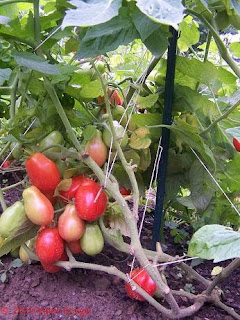What a view! What a day! Its nearly October, it was 92 degrees, sunny, with a gentle breeze as I stood beneath the shade of apple tree in my flip flops for perhaps the last time this year. Last week one of my neighbors was very kind to invite me to their yard to help harvest the plenitude of apples that their trees were producing this year. I was very honored indeed especially after seeing how beautiful her apples were and the care and attention that she gives to her trees. The trees are about twenty years plus old.
These apple trees were obviously well established. They were full blown mature trees, with thick sturdy trunks. The trees were not too tall, which made picking easier. My neighbor even gave me a tour of the trees and did taste testing. Delicious!
One beauty of a tree in particular was a granny smith apple tree. Granny smith just happens to be my boyfriends favorite apple, so I was very excited that of all the trees this one in particular had by far the most apples on it.
Now in anticipation of my apple picking visit I thought I'd try my hand at making my own apple picker. Knowing the trees wouldn't be too tall I figured a ladder wouldn't be necessary if I had an apple picker. The night before picking, I did some research online of apple pickers and got the general gist of what was involved. The next morning my boyfriend suggested using my garden cultivator to make the picker. In a few minutes I whipped together this apple picking contraption.
The idea I got from my apple picker investigations was that you would have something that would hook between the apple and the branch allowing you to pull down and break the stem.
Then your apples would fall and be caught by some kind of basket, in this case I used a juice jug that I cut the top off of and zip tied to the cultivator. I tested the apple picker on the ancient apple tree we have in the backyard and it worked well. Unfortunately after about half an hour of serious apple picking my picker started falling apart. Maybe it was the juice jug, or maybe it was the zip ties, but it just wasn't holding together. Oh well.
Regardless the apple picker helped me scour the upper branches of the tree to get a good five gallon buckets worth of apples. At her request, the most perfect looking apples were reserved for the local food pantry which she was going to drop off the fruit to in a couple days.
Immediately upon returning home the chopping began. My intention from the start was to try my hand at making applesauce. I've never made applesauce before, but from what everyone has told me its super easy.
With my paring knife in hand and following a recipe and some pointers from my mom, I quartered the apples- cutting out the cores and whatever insect/other damage I found. Then I cut smaller pieces into my largest stock pot. I cooked the apples for a little while until they started to become soft. Meanwhile I set up... my squeezo.
My squeezo. It may look complicated, but its really a simple and time saving tool. When I was a kid every August when the tomatoes were ready to make sauce out of, my job in the kitchen was to man the squeezo. It was so much fun!
Basically the tool allows you to separate juice and pulp from the skins and seeds of the food your processing. So in this case, I put the softened apples in the big funnel looking thing. By turning the hand crank and the food is fed through a spiral shaft surrounded by a screen that strains out the pulp and juice... which slides down into a waiting bowl, while into a second bowl the seeds and skins are deposited. I can only imagine how much time I saved in peeling the apples... I probably would have saved more by not coring them with my paring knife, but I was worried about worms (which I notice like to burrow from the bottom up through the center of the apple) and ended up just carving out that part for each apple.
The end result was so smooth and sweet. I didn't even add sugar. After passing through the squeezo the applesauce was done and ready for the canning jars!
Here are our 'orchard' in the making. These are four apple trees planted two years ago. Around here deer are very destructive and we knew we needed to devise a protective cage for all the saplings. I was explaining this to my neighbor who was having some problems with a sapling she planted, but which was getting abused by animals- so I promised to share our fencing method in this post.
First we secured stakes into the ground, here a U post on one side (something tall and strong) and a wooden one on the other. Using about 1/4" hardware cloth on the bottom extending upward about 24", the trees are protected from rabbits. On top of that is a heavier welded wire fencing which is about 48" tall. Both types of fencing were wrapped around and attached to the posts forming a protective cylander around the tree. Together the fencing stands about six feet tall. With mulch, weeds are not a problem and my boyfriend attached the fencing in such a way that allows flexibility for access to be gained for pruning or other maintinance.
At two years old the trees are looking mighty fine thanks to all of my boyfriends' hard work in caring for them. The time cannot come soon enough when one autumn day we can tromp out and pick our very own apple harvest from the backyard.



















































